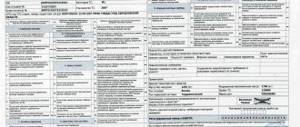Types of transport insurance
All car owners, without exception, are required to insure their car. The policy will allow you to resolve the financial issue of compensation for damage in the event of unexpected situations, for example, if the car is damaged in an accident.
To obtain a policy, citizens must contact companies that have special licenses to operate.
There are two types of insurance in Russia:
| Mandatory | In this case, all drivers are forced to sign an agreement with the Insurer, and after payment they receive a policy. |
| Voluntary | The document is drawn up only at the personal request of the owner. No one has the right to impose such a service. |
The procedure for obtaining insurance, whether compulsory or voluntary, has its own characteristics.
With voluntary insurance, companies provide a wider range of services. This is done in order to attract customers.
Is there a difference in the insurance procedure for individuals and legal entities?
The fundamental difference between individuals and legal entities lies in the tariffs for the service and the registration algorithm. When applying for standard insurance for legal entities, there are some peculiarities: some additional documents may be required that confirm the official registration of the business and other formalities.
For private clients, the difficulty lies in another nuance - it is more difficult to predict and reflect on paper who will use the transport and when (the number of people allowed to drive). Otherwise, the registration procedure for different types of consumers has discrepancies in the following points:
- Period of validity of the policy (for individuals, the minimum insurance period is 3 months, and the maximum is 1 year, but for companies the shortest period of time is six months, and the maximum is also 12 months).
- The number of persons who have the right to drive a vehicle (for control of the transport of a specific organization, the number of permitted persons is always unlimited, while for an individual this restriction may be present in the contract - no more than 5 drivers).
- Limit of compensation (this rule is established in fact not for the entire period of validity of the policy, but for each individual accident, and in case of repeated accidents, a legal entity can count on full compensation for damage each time, unlike an independent citizen).
- The presence of a trailer (in the case of an entire company, such an addition to the transport is also worth insuring, but an individual does not have to do this at all and the registration procedure remains voluntary).
- Basic tariff (initially, the amount of insurance for a car of any model for a legal entity is significantly higher than the amount of a similar service for a private individual).
Thus, by understanding the characteristic features and specific types of car insurance, you can always choose the most suitable option for each driver, so that in the event of an unforeseen collision or other emergency, financially protect absolutely all road users.
DSAGO
This is a type of voluntary motor insurance, issued at the request of the client. The policy is an analogue of compulsory MTPL insurance, but with an expanded range of services.
The main features are:
- DSAGO does not replace MTPL, so it can be issued at the same time, but not in exchange;
- It is allowed to register with another insurance company, but for the same vehicle, and the validity period must also match.
The main advantages and disadvantages include:
Pros:
- the cost slightly exceeds compulsory motor liability insurance, by about 1-5 thousand rubles;
- the amount of compensation increases significantly, the maximum payment can reach 3 million rubles.
Minuses:
- You can receive a payment under the MTPL only if the MTPL insurance does not cover the amount of damage caused. The victim will be paid the difference between the mandatory insurance and actual expenses.
Each insurance company sets its own limit on payments; the possible amount of compensation should be clarified with the company’s managers.
Dear reader! Didn't receive an answer to your question? Our expert lawyers work for you. It's absolutely free!
- Moscow ext 152
- St. Petersburg ext 152
- All regions ext 132 (Toll free)
To calculate the final cost, the coefficients used to determine the price of the OSAGO policy are used.
Types of insurance and how do they differ?
If we consider and compare all existing types of insurance, then first they can be combined into two large groups:
- voluntary (signed solely at the request of the owner, characterized by a wide range of insurance objects and situations in which damage will be compensated);
- mandatory (must be issued by every owner of a vehicle, without exception, and for the absence of such a policy, the driver will be prosecuted and fined).
Further classification of insurance depends on the specific object:
- Responsibility to other road users (the culprit of the accident is expected to compensate for property damage to the injured persons).
- Property from theft or damage (are voluntary and imply the protection of personal interests, regardless of who was to blame for the accident).
- Life and health (also required on a voluntary basis and designed to compensate for the costs associated with loss of productivity).
Recently, one of the fundamentally new versions of property auto insurance has become protection against mechanical and electrical breakdowns (not due to a collision). To eliminate such a defect free of charge, you can use an extended warranty from the manufacturer or an alternative contract from an insurance company. Also, so far the most common types of protection are MTPL, DSAGO, CASCO, accident insurance and green card.
OSAGO
Classic MTPL is considered compulsory insurance of civil liability of the car owner to other road users. Even driving is allowed only if you have this insurance, and in addition, there are several types of such protection:
- with a restriction (then a certain circle of persons admitted to management fits into the document);
- without restrictions (the paper does not mark specific individuals who are allowed to ride, but the price is much higher).
Also, the mentioned MTPL options differ in terms of validity, but even the proposed periods are strictly regulated (3,6 and 12 months) and it will not be possible to choose it arbitrarily.
In the future, payments under this agreement take into account the wear and tear of damaged car parts, by calculating their residual price and the amount required for repairs, if possible. And in case of total damage, the cost of compensation directly depends on its age and the established degree of wear. And in case of refusal to pay, the insurance company is obliged to indicate and justify the reason officially.
DSAGO
Another alternative in the form of DSAGO is not just an independent type of insurance, but rather an expansion of the capabilities of the previously described mandatory agreement option. This type of insurance is issued in this way only if there is compulsory motor liability insurance, and a related transaction is concluded for the same validity period and both policies expire at the same time. But you can get insurance from different companies, because in fact it is not the car that is insured, but the civil liability of its owner.
In practice, monetary compensation for damage under DSAGO is carried out in the order if it cannot be used to completely cover the costs of the first policy. The amount of the refund for repairs under MTPL is deducted from the entire amount of damage, and the remainder is paid in accordance with the rules of MTPL. The main advantage of this policy was its low price, with the help of which it is possible to significantly increase the volume of payments (almost up to 3 million rubles).
CASCO
Another voluntary solution is CASCO. But, unlike the previously discussed prototypes, the object of insurance here is not the owner’s liability, but his property. Therefore, in case of unforeseen situations, the owner of the car will receive compensation for its breakdown or damage: it doesn’t even matter who exactly caused the accident. Now there are various CASCO programs covering the following risk groups:
- Road accident.
- Unlawful actions of third parties.
- Hijacking.
- Disaster.
In theory, any CASCO is designed, first of all, to protect the owner of the vehicle from possible troubles.
Accident insurance
Since in car accidents not only cars, but also people who move with their help can suffer, many insurance organizations have voluntary insurance against health and life accidents in their list of services. Now at least 2 systems are used for calculating insurance payments in this case - by seats in the car and by a lump-sum system.
The first option assumes that each seat in the cabin is insured for a clear amount, which is received by the victim in an accident. And the lump-sum system makes it possible to insure the entire interior of the car, and if an insured event occurs, the entire amount of payments is divided equally between the victims.
The use of accident insurance under any scheme provides guarantees of compensation for treatment costs after an accident and material losses. In addition, this type of insurance covers losses associated with harm to health and life if the causes are natural disasters, natural disasters and fires. In the event of the death of any of the insured persons, the payment is transferred to the next of kin of the deceased.
Green map
International insurance policies valid in European countries, including member states of the Schengen Agreement, are called “green cards” in Russia due to the characteristic color of the registration form. Such car insurance is mandatory for driving on foreign roads, since this system is similar to the principle of Russian OSAGO.
The Green Card also insures damage caused to third parties or their property, thereby compensating the driver for the costs of treatment and restoration of the damaged car. The price directly depends on the exchange rate of the ruble against the euro and may fluctuate, but such protection in any case will be expensive - in the range of 4-6 thousand rubles. per month. But it will be useful only to those people who are going to go abroad with their car, otherwise it is more profitable to take a typical OSAGO.
CASCO
It is voluntary insurance. The main feature is that the policy is used to cover property damage, not civil liability.
The insurance company undertakes to cover all expenses, regardless of who was at fault for the accident. The list of services covers various unforeseen cases when damage is caused to the car:
- hijacking;
- traffic accidents;
- natural disasters;
- hooligan actions of attackers;
- heavy objects falling on the car (bricks or ice floes from the roof).
The following disadvantages and advantages are noted:
Pros:
- expanded range of possible risks;
- the amount of payments is significant, it can reach the cost of a new car;
- expenses will be reimbursed even if the driver is at fault for the accident.
Minuses:
- high price;
- there are restrictions when registering, for example, the car is old
An exception is when the driver does not receive compensation - the driver was drunk or fled the scene of the accident.
CASCO prices are not regulated at the state level, so each insurance company has the right to set its own prices. As a result, the price of insurance turns out to be impressive. You can calculate the cost of the policy on our website.
Types of car insurance in Russia
In the Russian Federation, you are allowed to take out several different policies for your car.
Types of car insurance for citizens and legal entities:
- OSAGO (compulsory);
- CASCO - voluntary insurance;
- DSAGO - car owner liability insurance on a voluntary basis.
OSAGO is a necessary precaution dictated by the state. OSAGO, in turn, implies different types of insurance. There are several types of such policies, and in the event of an accident, the amount of compensation also varies.
Voluntary CASCO insurance more fully covers the range of insurance services for car owners. A detailed description of CASCO risks also includes theft, accidental damage to a car in a parking lot, and car theft. MTPL does not apply to these cases.
This policy can be full or partial; its registration is carried out only on a voluntary basis. CASCO and OSAGO are similar, but do not duplicate each other. To apply for CASCO insurance, you will need to take into account the make of the car and its price category, age, driving experience, place of residence (regions differ in coefficients) and engine power of the car.
CASCO allows you to get insurance in case of car theft, attempted burglary, scratches, dents received while parking or in a parking lot and natural disasters. CASCO is often used in combination with MTPL.
In Russia there is another type of insurance - DSAGO. It is under this policy that the limit of compensation paid can be raised to 1-3 million rubles by paying for the policy in the amount of 1,000 - 5,000 rubles. DSAGO consists of liability insurance and the property itself. This is an additional and completely voluntary insurance. In combination with compulsory motor liability insurance, this policy allows you to receive significantly larger payments under a standard compulsory motor liability insurance policy.
Accident insurance
This insurance is one of the CASCO options. But in this case, the life and health of the driver himself and all persons in the transport are insured.
Insured events:
- accident;
- fire;
- element;
- explosions.
The advantages and disadvantages include:
Pros:
- All persons in the vehicle will receive the payment.
Minuses:
- There are restrictions on registration, for example, the age of the driver. Also, persons with 1 or 2 disability groups will not be able to get insurance.
If desired, the owner of the car can obtain the policy. Insurance will be paid if the driver and passengers are injured or injured. In addition, compensation is due in the event of temporary disability of the victim or death of the person.
Why do you need car insurance?
The subtlety of understanding the functions of compulsory motor liability insurance is that under this policy it is not the car or its owner that is protected from accidents and unforeseen circumstances, but the liability of the person who caused the accident to the injured party.
The cost of insurance is relatively low. There are different types of car insurance, which together allow you to protect yourself in a variety of situations. If a car is involved in an accident, the culprit will pay for repairs to the victim’s car, regardless of his own wishes.
Payments are made by the insurance company, to which you must submit all the circumstances of the incident, documents issued by the traffic police, checks and invoices confirming the cost of repairs. The insurance company reviews the case and provides payments.
All payments that can be received under compulsory motor liability insurance are strictly regulated. Only the amount is paid that does not exceed the limit for compulsory motor liability insurance. Insurance issued for a car does not include life and health insurance for the owner and driver of the car.
OSAGO can be issued not only for individuals, but also for companies, auto insurance is mandatory. The cost of an insurance policy for a careful driver who avoids an accident becomes lower. Theft and theft of things from the interior of a car are not included in the list of insurance cases under MTPL.
Conclusion
Vehicle insurance is designed to protect everyone who, voluntarily or involuntarily, is involved in the driving process.
A mandatory policy will cover losses caused to others who are involved in an accident involving the insured. And voluntary policies will significantly increase the security of the car owner. In a fast-paced city environment, the best option is to purchase all 3 auto insurance policies. OSAGO and DSAGO are quite affordable in cost, and CASCO insurance can be purchased with a franchise. But you, your car and your wallet will be protected.
Rate this article:
[Total: 4 Average: 4.8/5] (Article Rating: 4.8 out of 5)
Author of the article Elena Simakina Lawyer
How is compulsory motor liability insurance issued?
Registration of this policy is the responsibility of every citizen who owns a personal vehicle. In the event of an accident, he guarantees compensation for damage, the amount of which is calculated taking into account repair costs and the total coefficient. According to the current law, the following maximum limits for the amount of compensation are established:
- For property damage – up to 400,000 rubles;
- Causing harm to the health and life of persons – up to 0.5 million rubles;
These standards came into force on October 1, 2014. The policy is considered valid for 12 months. To obtain a policy, you must collect and provide the following documents:
- Original documents proving the client's identity;
- Car registration certificate or PTS;
- If the car is older than 3 years, a diagnostic card is required;
- If several drivers are driving a car, everyone is required to provide their driver's license.
In 2013, a unified electronic database was introduced in the Russian Federation, which stores all information about expired insurance contracts. This is convenient if you are re-issuing a policy. There is no need for the client to provide expired policies, based on the data from which insurers calculate discounts if no accidents were registered in previous periods. Insurers have all the necessary data obtained from the AIS.
What is the cost of insurance?
For an insurance company, the main indicator of profitability is the degree of probability of insured events. In this way, insurance risks are assessed and the policy price is calculated on this basis.
For MTPL insurance, there are uniform basic rates, which are adjusted depending on the conditions of use of the car. Therefore, the cost of compulsory car insurance can be calculated relatively simply. There are no fixed rates for CASCO, voluntary car insurance, or Green Card. In this case, you should only talk about the general parameters on the basis of which the cost is calculated.
The price is influenced by the following factors:
- Region of residence of the driver and use of the vehicle. Operating a car on bad roads and in harsh weather conditions contributes to the occurrence of insurance claims much more often. In cities, insurance will be cheaper due to the quality of the roads, but in megacities there is a factor of increased traffic density, which increases the risk of an accident.
- The driver's experience, accident history and age. For young people under 22 years of age, the cost of insurance will be higher, since a priori they do not have much experience driving a car. The cheapest insurance policy will cost drivers who are over 49 years of age and have extensive experience of accident-free driving. Drivers over the age of 70 will have to pay more because they are at greater risk of being involved in an accident or developing health problems.
- Type and make of car. The cost of CASCO directly depends on the market price of the car, and for different types of vehicles and their power there are their own MTPL rates.
- Year of manufacture of the car. The older the car, the greater the likelihood of a breakdown while driving, which can lead to a traffic accident. Accordingly, drivers of long-lived cars pay more for car insurance.
- The number and composition of people who drive the car. The situation can be quite complicated when the owner of the car is 50 years old, has 25 years of accident-free driving experience, and at the same time includes his twenty-year-old son, who received a driver’s license only a year and a half ago, in the insurance policy. In this case, the arithmetic average is not applied and it is considered that insurance is issued at the rate established for a young person with insufficient driving experience.
- Insurance company tariffs. Each of them sets tariffs for CASCO and DSAGO independently. Insurance companies that have only recently started operating in the Russian auto insurance market usually offer lower rates, aiming at dumping. More reliable insurers have long since passed this period and set much higher prices. At the same time, car owners’ confidence in them is much higher.
- Duration of the policy. It may vary, but cannot exceed one calendar year. As a rule, insurance companies issue insurance for three months, six months or a year. You can also specify a period during which the vehicle will not be used.
A young driver always pays more for insurance
For example, an MTPL agreement is concluded on September 1. It is valid for a year, and the driver must receive the next insurance before September 1 of the following year. But the car owner is not going to drive the car in winter. To reduce the cost of insurance, he can indicate the period of operation in the contract. From November 1 to March 31, insurance will not be valid. But during this period, this person does not have the right to drive his car, since he actually does not have insurance. If during this period of the year he is stopped by a traffic police patrol, then, accordingly, he will issue a fine for lack of insurance.
To select the optimal cost of an insurance policy, you must, first, select the type of car insurance and select a set of options that must be included in the insurance contract. Secondly, you should study the rates and conditions of insurance in several companies to choose the most acceptable ones.
To calculate the cost of insurance, it is not at all necessary to pay a visit to the insurance company. You can use an online insurance calculator. There is simply no single online calculator, since each insurance company (or broker) creates a corresponding online resource independently and under its own brand. But there are sites where you can compare several offers. For example, the cost of compulsory motor liability insurance can be calculated on the RSA website. Sravni.ru gives you the opportunity to choose CASCO insurance from 97 companies. The principle is the same everywhere: the car and owner data are entered into the fields, the approximate cost is calculated automatically.
You need to enter the necessary parameters into the online calculator, and the cost will be calculated automatically
Types of MTPL insurance
Types and categories of car insurance
| Auto insurance type | Liability insurance for the culprit of an accident | Car insurance for the person responsible for the accident | Life and health insurance | ||
| Auto insurance name | OSAGO | DOSAGO | CASCO | Driver insurance | |
| Insurance type | mandatory | voluntary | |||
| Policyholder | the culprit of the accident | ||||
| Beneficiary | Injured in an accident due to the fault of the policyholder | policyholder | Passengers of the policyholder's car | ||
| Maximum payout amount | If in an accident the car is destroyed or the cost of repairs exceeds the amount: 400,000 rub. (property) 600,000 rub. (health and life of people) | impressive amount | market value of the insured vehicle | impressive amount | |
Since an insurance policy is necessary in different circumstances, for different periods and for different operating conditions, a division by type of insurance is provided.
In 2021, compulsory motor liability insurance differs in terms and is issued in two types:
- Limited insurance;
- No limits.
The policy can be presented in paper or electronic form. There is also a travel type of insurance. Every year new types of paper policies appear. They vary in color and shape of protection. At the moment, a metallized strip sewn into the paper indicates that the policy is original. Changes are necessary to protect car owners from scammers.
With or without restrictions
The most common types of insurance are divided into compulsory motor liability insurance with and without restrictions. Limited insurance is valid only for a certain number of people who are authorized to drive the insured vehicle. The rules prohibit anyone from driving who is not included in a valid insurance policy.
If this is discovered, the car owner will have to pay a fine. In the event of an accident, insurance payments will not be made, but the victim will still receive compensation for damages from the personal funds of the culprit. By limiting the circle of people, the risks of entrusting the car to an inexperienced or unnecessary driver are reduced.
An extended insurance policy without restrictions does not in any way regulate who can drive a car (as long as the drivers have a valid license).
The cost of OSAGO insurance is noticeably higher than that of a limited vehicle, but anyone the owner trusts can drive this vehicle. A policy with restrictions is beneficial for a family, but not for a company. However, what exactly to choose is up to the owner of the vehicle.
By timing
The validity periods of MTPL insurance policies vary, but you cannot choose them arbitrarily. For all insurance programs, a quarterly, six-month and annual grid applies. You can choose one of the options, and those who drive their car into the garage for the winter until spring prefer shorter insurance periods. For summer residents, there is a seasonal MTPL policy, which is very convenient in terms of saving money when taking out insurance.
By choosing a short-term policy, the car owner will save money on additional purchase of DSAGO insurance. Thus, all risks of damage to property and health will be provided for and the person will be protected not only from the point of view of compliance with duties, but also from the point of view of protecting his property rights. Individuals receive a large amount of compensation.
Payout limit
Covering damage resulting from an accident is the main task that the MTPL policy solves.
The amount of compensation that participants in an accident can count on is strictly regulated.
There are two types of compensation: property compensation , that is, vehicle repairs, and health compensation .
Compensation of the first type has the following restrictions:
- If there are two participants in an accident , the payment limit is 120 thousand rubles.
- If three or more objects are involved in an accident, the limit is 160 thousand rubles for all participants.
Limitation of compensation for health and life: each victim in a traffic accident can count on payment of up to 160 thousand rubles.
In addition, every car owner should remember that under one MTPL policy you can pay an amount not exceeding 400 thousand rubles . In most situations, such amounts are quite enough to cover all the damage caused; in other situations, the difference will have to be paid to the culprit of the accident himself.
Car loan insurance
If the car is taken out on a car loan, then most likely you will have to apply for CASCO insurance in addition to the mandatory compulsory motor liability insurance. Why? And is this always the case?
A car for which the loan has not yet been fully repaid remains, as it were, collateral (albeit the property of the owner). If after an accident it is not recoverable or is stolen, the bank will not be able to receive the full amount or use the collateral due to its unworthiness or absence. Naturally, this is not profitable for the bank. Most likely, in the car loan agreement, the owner will be required to issue a full CASCO insurance so that the bank, if something happens, can “close” this loan.
You can find a bank that will not force you to do this - but there will be a very high interest rate. That is, the money will be about the same. There is another option - not to take a car loan, but a regular consumer loan for general needs. But here too the rate will be higher.
What is the Russian Union of Motor Insurers
The Russian Union of Auto Insurers is a non-profit organization that unites under its wing many insurance companies operating in the field of auto insurance. The birthday of the RSA is considered to be August 8, 2002. The organization was created in advance even before the adoption of the law on compulsory motor third-party liability insurance for Russian drivers. In August 2002, it became clear that the corresponding bill would soon be approved, and therefore insurance companies began to be created en masse, intending to work in this market. Today the Union has 70 full members and six observers. In this case, we are talking about both Russian insurance companies and representative offices of foreign insurers.
The main functions of RSA include:
- ensuring interaction between all insurance companies that are members of the Union, and developing rules for working in the Russian auto insurance market, as well as monitoring their compliance;
- protecting the interests of insurance companies that are members of the Union in government bodies;
- exercising control over compensation payments upon the occurrence of insured events in accordance with concluded contracts and the requirements of Russian laws;
- providing information support regarding the law on compulsory motor insurance and the activities of companies.
RSA has representative offices in all federal districts of the Russian Federation. If an insurance company is declared bankrupt, then in this case the Union’s task is to ensure the fulfillment of insurance contracts concluded with it and the payment of compensation for insured events. For this purpose, RSA reserves 3% of the premiums received from insurance companies. Naturally, if more than 50% of insurance companies are declared bankrupt, the Union will have quite serious financial difficulties associated with payments.
The Union of Automobile Insurers found itself in a rather difficult situation during the economic crisis of 2009, when 36 Russian insurance companies were declared bankrupt. All payments on their debts were to be made from the RSA reserve fund. Since there were many bankrupts, compensation payments had to be delayed. This caused discontent among Russian car owners, and the Union itself was mercilessly criticized in the media. But over time the situation returned to normal.
RSA ensures interaction between auto insurers
In 2015, there was a case when a driver insured under MTPL became the culprit of an accident. After resolving all the issues related to registration, he was horrified to learn that his insurance company was declared bankrupt and its license was revoked. But the damage to the third party was considerable, and the damaged car was a luxury car. First of all, the insured person at fault for the traffic accident contacted a lawyer. But he reassured him, explaining that even if the insurance company goes bankrupt, payments for compensation for material damage to injured third parties will still be made, but not by it, but by the Union of Auto Insurers. To do this, it was necessary to write an application and send it by registered mail or email. Compensation was still paid. To the extent that was provided for in the MTPL insurance contract, but not within the same time frame. During this time, the national currency exchange rate dropped significantly, and the cost of spare parts and repairs for the damaged vehicle increased significantly.
What is car insurance and why is it necessary?
Every day, looking through the chronicle of incidents on Russian roads, many people think: “Of course, this happens, but it won’t happen to me.” At the same time, even in unforeseen situations, many feel calm. After all, they have insurance.
Main goals of car insurance:
- creation of financial guarantees to compensate third parties for material damage or harm to health (this is motor third-party liability insurance, in Russia it is mandatory);
- protecting your own car from theft, damage as a result of an accident, natural disasters or acts of hooligans;
- improving road safety and driver discipline.
The car owner pays the insurance company once a year. And she, in turn, pays compensation when an insured event occurs. If nothing happens, the money remains in the company and is not returned to the owner of the car. But compensation can be several times higher than the premium paid.
Car insurance can be considered the same age as cars themselves. It arose when there were a lot of four-wheeled cars on the roads and periodically they began to hit each other, run into pedestrians or crash into trees. The first auto insurance company emerged in the United States during the First World War. After the end of World War II, auto insurance became widespread. Today, cars are insured in almost all countries of the world, but legal requirements differ markedly. In some states, insurance is included in the list of mandatory documents, while in others, drivers can insure themselves at their own request.
Car insurance protects against damage and promotes driver discipline











